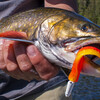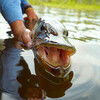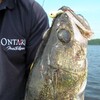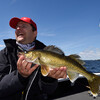
Judas Bait Muskies

One of our best muskie baits so far this season has been a Magician — literally and figuratively. It is a surface lure made by Port Perry, Ontario-based Fish Whistle Lures and at first glance, you would think it is just like any other walk-the-dog style stick bait. The difference, however, is when you spot a big toothy critter following the lure, you can rip it down and work it in front of the fish’s face as a subsurface glide bait. So, it is two completely different lure styles in one. Now, are you ready for this: we’ve only caught a handful of fish on it so far. If that sounds like a contradiction, it is not, because the lure has functioned remarkably well as a Judas bait.

Use big surface baits to use to get muskies to show themselves and then return later and catch them. (Photo credit: Gord Pyzer)
If you’re not familiar with the term, it is a lure that excites the fish and calls them in from far away, getting them to show or betray their presence, hence the name. Bass anglers, in particular, preparing for tournaments will routinely remove the hooks from their baits during practice — or cover them with hollow plastic tubing — so they can’t inadvertently sting or hook them when it doesn’t count. They will cast the Judas baits with the sole intention of getting the bass to betray themselves and show the angler where they’re hiding. Then they will go back during the tournament and catch them.
A few days ago, my grandson Liam and I were fishing a lush deep weedline on a Sunset Country lake. Liam was casting a double-bladed #10 Handlebarz bucktail, while I was pitching and ripping a Water Wolf Gator Tube. At the end of the 100-yard stretch of grass, we hadn’t seen, felt or raised anything, so I turned around the Kingfisher and made another quick pass. This time I was throwing the Magician and less than halfway down the weedline, a gorgeous muskie shot out from the cabbage and chased after the bait. I immediately pulled the Magician underwater and ripped it glide bait-style, and the muskie followed it to the side of the boat where it circled half-heartedly, despite my desperate figure-eight attempt, before sliding away. But, like Judas, after whom the technique is named, the big toothy critter had betrayed itself. So, I hit the waypoint button on the Helix Chartplotter to lock in the fish’s location and Liam and I left.

Once you know the location of a big fish, rest it until the conditions are ideal at moon rise and sunset. (Photo credit: Gord Pyzer)
I should mention, at this point, that when I raise a nice fish and it slinks away halfheartedly during the figure eight, I don’t like to whip the water into a froth casting a variety of other baits trying to coax it to bite. I will if there are a lot of other boats around and I don’t think I can guard the fish until I return later. But on most big waters in Northern Ontario, it is rare to be bothered this way by other anglers. So, I restrain myself from putting the fish on guard and instead of bombarding it with lures, I pull away and leave. But, you can be sure that I’ll return as stealthily as possible in the afternoon or evening — especially at moonrise or sunset— and try to catch it when it is in a more aggressive feeding mood.
And that is what happened this day when Liam and I returned about three hours later as we were working our way back home. Knowing precisely where the fish had been positioned earlier in the day, we resisted casting our way onto the spot and possibly spooking the fish. But when we were properly positioned, we started pitching our lures precisely and scanning the area behind our baits like eagles, expecting to see the fish on every cast.

Returning to the spot where you raised a nice northern pike will also pay good dividends. (Photo credit: Gord Pyzer)
I hooked it off a totally nothing-looking nondescript piece of shoreline with no weeds, boulders or cover whatsoever. It was a simple flat bedrock slope that you would never have fished unless you had first used a Judas bait to get the fish to betray itself.
The verdict? Definitely worth it.
Recommended Articles

Cast Into the Heart of a Walleye Paradise

Brook Trout: A Natural Work of Art

Crankin' in Crappies

Long Nose Gar

Streamers for Big Pike
Indian Lake Lodge

Spring Walleye

Chiblow Lake Smallmouth Adventures
Eagle Lake Lunge

Late Season Panfish
Troutfly Lake Outpost

A Whole Lota Lovin'

Dog Lake Walleye

Dogtooth Lake Resort Smallmouth
Top 5 Musky Destinations in Ontario

Cranking Up The Heat in Northern Ontario

Killarney’s Pike Fishing Paradise

Ice-out glory

Musky Mayhem in the Kawarthas














